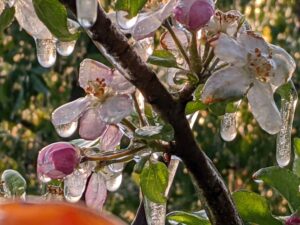When I started the orchard, I was fairly naiive to the issues I would be up against. As far as weather was concerned, I knew there were apple orchards just 5 miles or less from me, and I really didnt give late frosts and freezes much thought.
As I recall, I knew our growing zone was 6b with an average minimum temperature of -5 degrees F. Even so, for the past five years or so, it had been pretty warm, with very little snow in the winter. Our back yard slopes fairly significantly as it leaves the house and drops down toward the creek. The orchard is about 8 feet above creek level, and it was not unusual to experience that pockets of cold air as I walked around in the winter.

The first couple of years went by and with no fruit on those trees, and there was little to be concerned about. I set about adding trees in a fairly quick succession. Random plantings gave way to a more orderly approach and I started adding a second row. Still with no fruit, and I set about learning more about pruning (I love pruning!), spraying, and the like.
Finally as the trees grew, I was starting to see more and more blooms but still no fruit. One particular year, there had been a significant number of trees blooming in the early spring. Blooms had already given way to the start of tiny fruit on peach, pear, and plum trees when I went inside for the day. Fast forward to the next morning. I walked down to the orchard early since it had been a cold night. Every single tiny fruit I checked had turned black. Later in the day, all the peach blooms had turned dark yellow and were clearly dead. I was heartbroken.
Looking back, this was a watershed moment for me. The challenges I would face with unpredictable weather and the lack of control that I had over it were starting to sink in.
Things were not going the way I expected.
This was 2020 and lots of folks on growingfruit.org were complaining about losing their crop. That year I did not have a single fruit. No peaches, pears, plums, or even apples. Nothing. It was terribly discouraging. We decided to put up a weather to station to better monitor the temperature. I wanted to know the true temperature at the orchard, and Paul located it near the first row of trees. We were able to connect with Weather Underground and display our information on their map. You can connect to our station at this link.
Wilbourn House Brownsburg Station Weather Underground

We could confirm that the temperature down by the trees is actually as much as 8 degrees lower than at the thermometer we had placed closer to the house! On nights when I though it was 32 degrees, it was actually much, much colder. What is 8 degrees in the scheme of things in an orchard? Everything! Since 28 degrees is the temperature where fruit starts to be damaged, we had often experienced lows that were affecting fruit production and I did not realize it.
Even though I did not know the true temperatures in the orchard initially, I had tried several methods to protect fruit over the years.
My first years were spent covering the trees with blankets or cloth. I was able to do this pretty well since the trees were small and they were surrounded by a wire fence surround that could support the cloth.
One year I drove our ATV Cushman around the trees with double propane tanks strapped on and the flame aimed at the trees. I drove continually through the freezing orchard from about 9pm until the temperature warmed when the sun came up, roughly 10 hours. Pretty unbelievable as I think of it years later.
Another year I lit a big bonfire in the middle of the orchard and kept charcoal fires going under blooming trees all night long. Lots of pots full of lots of charcoal!
This past year I did a trial of spraying water on the trees since the effect of water freezing releases a small amount of heat and keeps the blooms and fruit no colder than 32 degrees
 I think it was partially successful, as many of the open buds appeared untouched even in the 26 or so degree temperature. I would like to try this on a larger scale in the future. You can read more about the use of spraying water on trees to prevent frost or freeze here
I think it was partially successful, as many of the open buds appeared untouched even in the 26 or so degree temperature. I would like to try this on a larger scale in the future. You can read more about the use of spraying water on trees to prevent frost or freeze here

Sprinkler Irrigation for Frost Protection
I have no doubt that there will always be challenges about growing fruit in the tiny village where I live. Each year I try new things, and little by little, my harvest is getting bigger. Encouraged by successes, I will continue to persevere in the hopes of another year of delicious fruit.
In the words of the Peter Gabriel song
Don’t give up!
